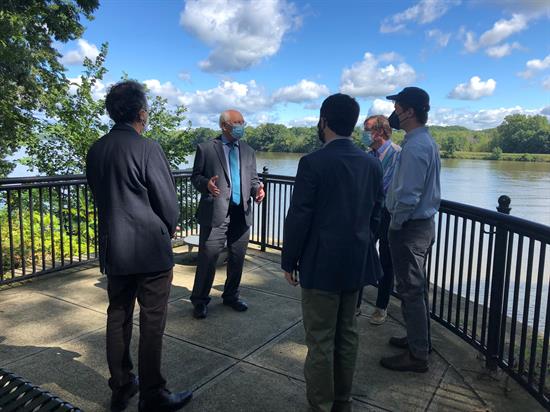- Home
- About
-
Constituent Services
- Academy Nominations
- Community Project Funding
- Congressional Art Competition
- Congressional App Challenge
- Congressional Commendation
- Event Invitation
- Grants
- Help with a Federal Agency
- Internships
- IRA Clean Energy Consumer Benefits
- Know Your Rights: Immigration
- Request a Meeting
- Request Surplus Books
- Presidential Greeting
- Visit Washington D.C.
- Issues & Legislation
- News
- 20th District
- Contact

Press Releases
Tonko Questions Local Expert on NY-NJ Watershed Protection BillNatural Resources Committee holds hearing highlighting New York-New Jersey Watershed Protection Act to restore watersheds and estuaries
Washington,
January 20, 2022
WASHINGTON, DC—Congressman Paul D. Tonko delivered remarks and questioned experts on his New York-New Jersey Watershed Protection Act during a subcommittee hearing today. Congressman Tonko’s bill was introduced in the Senate last week by Senator Cory Booker, alongside cosponsors Sens. Charles Schumer, Kirsten Gillibrand, and Robert Menendez. Andy Bicking, Director of Government Relations and Public Policy at Scenic Hudson, joined as an expert witness to emphasize the importance of this legislation for preserving the environmental and economic health of the Hudson and Mohawk River regions. Watch video of Rep. Tonko’s questions for Andy Bicking HERE and read his statement as prepared for delivery: Thank you, Chairman Huffman and Ranking Member Bentz, for the opportunity to address the Subcommittee and for including my bill, H.R. 4677, the New York-New Jersey Watershed Protection Act, in today’s important hearing. Our Watershed includes six major rivers across our two states, their tributaries and estuaries, and the numerous communities that these waterways have shaped for centuries. New York’s 20th Congressional District, situated at the confluence of the mighty Hudson and historic Mohawk Rivers, is blessed to be a part of this great Watershed. Centuries ago, these waters powered our mills, carried goods from the coast to the rest of the nation, and inspired the growth of a necklace of mill towns, including my hometown of Amsterdam. Today, the Watershed is the nation’s most populous, home to more than 15 million people. Millions more visit each year, supporting a multi-billion-dollar recreation and tourism industry. These vital water resources also serve as sources of drinking water for millions of people and provide habitats for more than 200 fish species and several endangered and threatened species. However, our industrial heritage creates unique challenges for our cherished communities and ecosystems. Many mills have since closed their doors. Hazardous waste and legacy chemicals, including PCBs, from the factories that built our economy years ago remain unacceptably high, threatening the health and safety of ecosystems, wildlife, and human health throughout the entire Watershed. The metropolitan area includes more than 500 miles of coastline, yet due to pollution and mismanagement, only a scant few of those miles are available for access and recreation, and even fewer in communities experiencing environmental injustice. Our communities are already witnessing the devastation of sea-level rise, increasing storm surges, and flood risks, all made more severe by the growing effects of climate change. The extreme floods that endangered families and communities over the past year were tragic and should compel us to re-think our connection to the waters of our region. I have always believed that the power of our waters can be harnessed once again to transform the region in the twenty-first century. We can build an economy today that uses our mighty waters, not as sources of harm and pollution to local communities, but for enhanced public health, cherished gathering places, public outreach and education, and the celebration of a heritage that grounds us in our deep roots while propelling us into a cleaner and more just future. Our waterways are the key to that future – one filled with smart development, innovation, and new jobs – if we respect and care for them. My bipartisan New York-New Jersey Watershed Protection Act will turn the tide for these waters by establishing a targeted role for the federal government in the implementation of a holistic, basin-wide strategy to coordinate local restoration projects that promote healthy ecosystems and improved coastal resilience, water quality, and public engagement. This collaborative model to help the Watershed address its greatest challenges will encourage collaboration among key partners, build on state and local efforts, and leverage private dollars. Our Watershed is America’s most crowded, and it has had nationally significant cultural, ecological, and economic impacts on our nation for centuries. Managing this public resource and its many services requires leadership and collaboration from all levels of government. Yet, every other watershed that supports a population of this size has received significantly more federal investment. The Delaware and other regional watershed programs have been hugely successful, and I have woven their models into this legislation. Our Watershed must be considered alongside our nation’s most significant waterbodies, and receive the same federal support, so that it can remain a critical natural resource and national economic engine for generations to come. I am proud that this legislation is supported by 26 bipartisan Members from around the Watershed, and I would like to thank my partners in the Senate who recently introduced companion legislation. We have also received letters of support from state agencies, local governments, and more than 50 local organizations, whose meaningful restoration plans can finally be implemented with the support and coordination offered by this legislation. I would like to request to submit their letters into the record, Chairman. This long overdue effort to manage the vital water resources that bind together the communities, economies, and heritage of the region would launch a new chapter of prosperity and equity for the New York-New Jersey Watershed and deliver untold benefits in conservation, ecosystem health, human health, and community development. ### |
